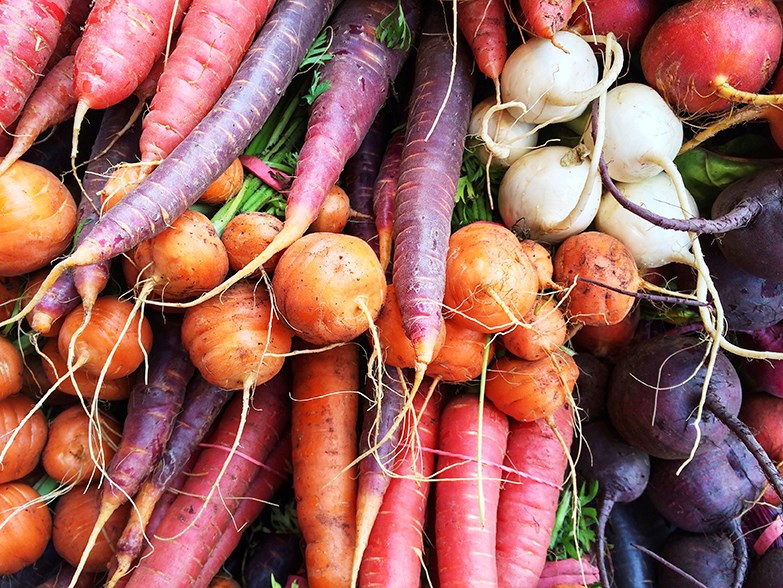Root veggies: love them or hate them, most of them are available year round for your inexpensive eating pleasure. And although some may resemble aliens or genitalia, they are packed with nutrients and minerals that will do your body good.
Unfortunately they are often unappreciated, taken for granted and tossed aside into a side dish. However, I encourage you to become a root veggie ninja and sneak them in a main dish, get your nutrients and show off your culinary skills like a boss.
Root vegetables generally grow underground, soaking in the nutrients from the soil. Unfortunately, they can also absorb toxins from the ground, so choosing local and organic is always the better option whenever possible. Another way to get more from your root veggies is by selecting fresh and firm produce, as it will enhance the flavour and nutrient content.
I’m sure you are already pretty familiar with a lot of root vegetables as they tend to be staples in most kitchens: carrots, potatoes, beets, sweet potatoes, yams, turnips, daikon, radishes and parsnips, onions, as well as spices such as ginger, garlic and turmeric.
Making root vegetables a part of your regular diet is a great way to make sure you are getting enough nutrients into your body. They also contain slow digesting carbohydrates and tons of fibre to keep your flow on the regular, if you get my drift. They can be eaten cooked or raw for your eating pleasure. Steam them, boil them or even grate them into a salad. There are many ways to reap their many health benefits.
Potatoes
Believe it or not, this is the number one food crop in the world and they come loaded with vitamin C, B6, antioxidants, potassium, manganese and copper. The next time you get yourself a spud, I encourage you to really savour and feature it’s flavours by just adding some butter and maybe salt and pepper; don’t drown it out with a million toppings you know you don’t need. Keep stored in cool dry place (not the refrigerator) so it will keep longer, and avoid the temptation of storing it in a plastic bag, brown paper bag is best to not trap moisture.
Carrots
They come in a variety of colours other than your traditional orange, have you ever had a purple carrot? They are pretty delicious and super fun to play with. Carrots have been known to be great for the eyes and are high in vitamin A, B, C, E, and K, and you can even eat the tops (try adding them to soups or even a salad).
Onions
Great for your intake of vitamin C, folate, potassium and copper. These lovely balls of fun help support better bone density, are good for your cardiovascular system and have antibacterial properties. Onion fun fact: The outer layers are more nutrient dense than the inner layers, so don’t over-peel!
Beets
These purple-coloured root veggies are packed with antioxidants, vitamin C, magnesium and iron. They are great for your blood and your nervous system. Enjoy them steamed, roasted and even raw. The world is your oyster, your very purple oyster. I suggest you don’t wear white.
Parsnips
Before potatoes took over, parsnips were the most popular kids on the block and a household staple. They look like big white onions and are a great source of vitamin C and manganese. If you like retro things then parsnips are your game. Get adventurous out there, no regrets!
Recipe: Roasted beet salad
Ingredients:
3 medium-sized roasted beets
½-1 bulb chopped fennel
¼chopped red onion
2 bulbs crushed garlic
½tsp fresh thyme
¼tsp dried oregano
1 tsp olive oil
1 tsp apple cider vinegar
Himalayan salt and pepper to taste
Directions:
Peel beets and slice them into circles (like potato chips, but thicker)
Roast them at 375F with salt, pepper and ½tsp olive oil and apple cider vinegar until they are soft.
Place roasted beets in a bowl and mix with other ingredients and add the rest of the vinegar and Oil. You can also add some more salt and pepper if you’d like. Enjoy!



